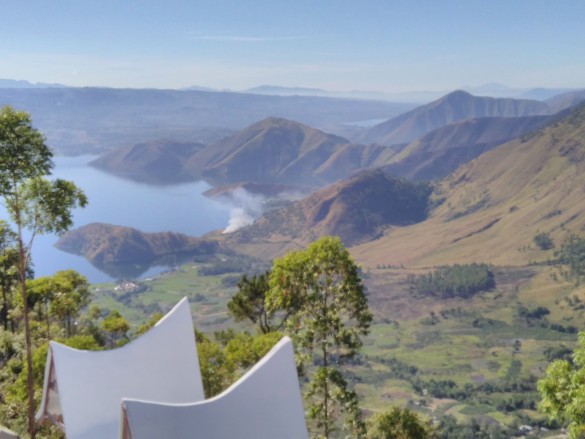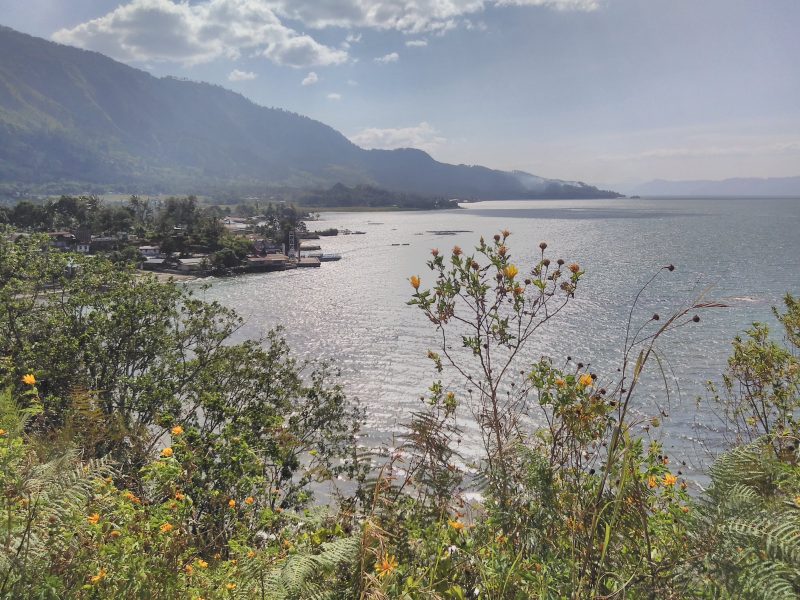The mighty Lake Toba remains one of Indonesia’s most impressive stop-offs
Outside of Bali, the dodgy pizzas and dishevelled hotels that are the mainstays of Indonesian tourism still have a way to go before the pasty skinned doyens of international globetrotting and backpacking start flocking to the country in anything like the numbers that they do to neighbouring Malaysia (27 million in 2015) or Thailand (30 million in 2015). North Sumatra remains one of the country’s better-known spots however, as dotted around the central city of Medan you’ll find the huge Gunung Leuser National Park for jungle trekking and orangutan spotting, the volcanic highlands and hiking of Berastagi and, of course, the picturesque shores of the mighty Lake Toba, which despite not being the backpacking hippie epicentre that it once was in the 1960s, still has enough going for it to attract a decent amount of global travellers and dreadlocked jugglers to its shores.
To get to enjoy this bucolic beauty, one first has to negotiate the crumbling sweatbox that is Medan, which is unlikely to win a Lee Kuan Yew World City Prize any time in the near future. It was during the recent Lebaran holiday that I decided to return to the shores of Toba after my first visit a number of years ago. This time though, I brought my bicycle with me and embarked on a week-long tour of the area. I’d been to Medan before then, however the sense of anticlimax as I pedalled my way from the city’s brand spanking new Kualanamu Airport deep into the downtown area was still so intense that I feared that my tyres would start to deflate.
Indonesia’s third largest city is, let’s be honest, a hot, dusty and thoroughly knackered urban population centre but it is, let us not forget, surrounded by simply stunning countryside. This is a pattern you’ll find repeated all across Indonesia. North Sumatra is a fascinatingly varied province, and ranges from sweltering planes to cooler highlands, and from traditional mosques to church steeples. My ride from Medan to the pellucid blue depths of Toba offered me the chance to take in all of these elements, as I simultaneously tried to not get mown down by the suicidal bus drivers who were also plying the same route.
As the road nears Toba, it gradually rises up by half a kilometre to the huge ridge that runs around the perimeter of the lake that now fills the enormous mega-volcano caldera. There are some spectacular views and photo opportunities to be enjoyed from up here. As one nears the lake, it’s nice to try and stop to take a few pics and have a coffee at one of the many cafes, before finally sweeping down to the lakeside town of Parapat and reeling off a few snaps.
At the opposite side of the lake, the road sweeps back up to the ridge to a height of 1,500m from the town of Pangururan (on the lake’s island of Samosir) across to the mainland and all the way up to the ridge top town of Tele. Don’t miss this one, as the views all the way up are some of the best you will ever see. There’s also a lookout tower at the top, which is a fun little local tourist attraction.
Crossing over to the lake’s island of Samosir by boat is undertaken from the lakeside town of Parapat. Samosir is what Lake Toba is really all about and the 30km-long island is the spiritual home of the Bataks, one of Indonesia’s best-known ethnic groups, and remains largely untouched by the rest of the world. The Bataks themselves are a proto-Malay tribe who are descended from Neolithic mountain tribes who originally hailed from Myanmar and northern Thailand.
Thankfully, the Bataks no longer practise cannibalism and are now mainly Protestant Christians whose lands extend a couple of hundred kilometres north and south of the Batak ground zero of Toba.
Today, the region’s 6 million Bataks are famous for playing guitars and other traditional instruments, singing hymns, chomping on pork, drinking beer, being filled with joie de vivre and for generally calling a spade a spade, in contrast perhaps with their brothers and sisters over in Java.
Toba itself is the largest lake in Southeast Asia and covers an amazing 1,707sq.km, while the island of Samosir is almost as large as Singapore. Directly opposite Parapat, you’ll find yourself sailing to the sweet little peninsula known as Tuk Tuk, which boasts the lake’s greatest concentration of tourist facilities. Here you’ll be greeted by a wealth of guesthouses and restaurants. Check in, have a beer, and then why not have a swim in the lake itself? Most of Tuk Tuk’s hotels and guesthouses offer access to Toba’s cool blue waters.
Then you should think about exploring the island via its sleepy roads. Simply rent a bicycle or motor scooter and away you go. Don’t forget your camera though, as you will find plenty to snap along the way, from stunning views of the lake and its surrounding hills to beautiful, traditional Batak houses with their distinctive curving roofs. There are even beaches further up the coast to the north of Tuk Tuk, which you will no doubt stumble across as you roll past rice fields, sweet villages, traditional multi-storey Batak graves marked by crosses, lush volcanic countryside, traditional churches and unique local architecture.
If you fancy trekking, then you can hike along trails up into the island’s interior. The hills here rise up to some 700m above the level of the lake and offer more sensational views. There are also a few sites of historical interest to check out too, including the grave of King Sidabutar, the monarch responsible for converting the Bataks to Christianity, the Huta Bolon Simanindo Museum, and the famous megalithic stone chairs at Ambarita, where miscreants were once beheaded.
Heading further back into human prehistory though, perhaps Toba’s most amazing claim to fame involves the huge mega volcano, the caldera of which the lake now occupies. The 1883 Krakatau eruption, huge as it was, was ultimately peanuts in comparison with some of the mega volcano super eruptions that have occurred throughout geological history. The most recent of these super eruptions spewed forth from the massive crater that now holds the enormous lake around 70,000 years ago.
This eruption is described by scientists as being “mega colossal”, and is thought to have caused a decade-long volcanic winter, as well as a 1,000-year-long “cooling episode” over the entire planet. By coincidence, geneticists have discovered that our species, already flourishing at this point, hit a so-called, “population bottleneck” around (drum roll, please) 70,000 years ago.
The theory is that the Toba eruption proved so utterly catastrophic to the environment that humanity was reduced to maybe a thousand breeding pairs before the population eventually re-expanded many years later. Indeed, DNA evidence shows that we are all much more closely related to each other than we should be, given the age of our species.
So there you have it. We really are all brothers and sisters, and it’s all thanks to Toba!
FAST FACTS: LAKE TOBA
Size: 100km long, 30km wide, 500m deep
Province: North Sumatra
How to get there: Fly to Medan’s new Kualanamu airport and then take a three-hour bus ride.
What to do: Swim, cycle, take photos, hike, drink beer, enjoy the amazing views and, above all, relax.
What to bring: Swimming kit, decent footwear, sunblock, camera.




